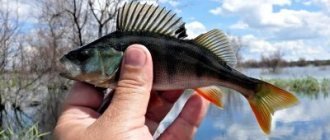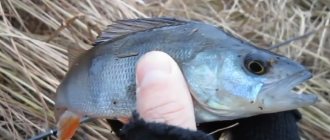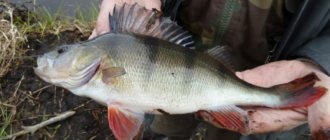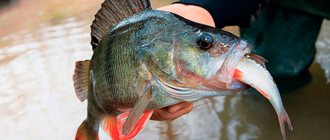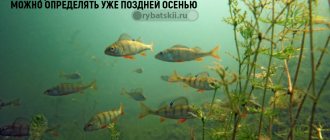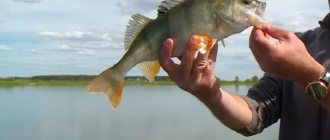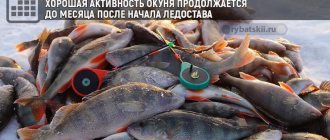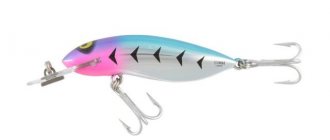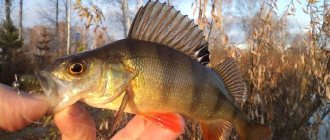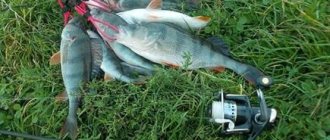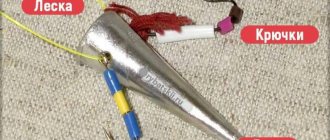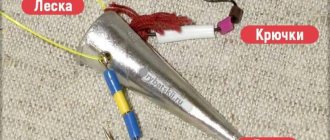Sea bass - description
Sea bass is called “Sebastes” in Latin. It is part of the scorpionfish family, which completely debunks the myth of its similarity to the freshwater cousin of the ray-finned fish.
The appearance of the predator is original in its diversity. The body has some exceptional secrets. The “sailor” by nature has the means of defense against external enemies. The fin on the back ends with spiny and soft rays of poisonous glands. The poison is fatal to predators of the aquatic world, but for humans, when it comes into contact with the skin, it causes unpleasant sensations and itching.
Rich species emerged from a wide range of habitats. In the world's water bodies, there are officially more than 120 types.
The geography of existence of the pseudo-brother of the river individual touched the depths of the sea, settling there several popular types of predators. Afterwards, numerous turbulent currents resulted in the deep-sea development of two oceans - the Pacific and the Atlantic.
The structure of the perch that plows the blue depths is basically similar to the river one. Especially in the younger years of life. The differences begin in adult marine specimens from the head - they are significantly larger than the river specimen. The shape of the eyes is convex. The eyes are very similar to glass hemispheres. But most of all, sea bass differs from freshwater in the color of its scaly skin. A predatory “sailor” of a bright red hue. The density of its scales covers part of the perch's head, like a helmet or shield. This way the fish is reliably protected from third-party interference and attacks. The carcass is covered with small tubercles and spines. The fins are decorated with the already mentioned glands with poison.
Red scales divide the predator into shades. The back is darker, almost brown in color. The belly is lighter than the main color. In addition to all this, perch fish from salt water bodies can be of a single-color, striped color, with frequent spots on the body. The main color that nature settled on is pink-red.
The weight of an individual (male or female) is from 1.5 to 3 kg. Ocean “heroes” weighing up to 11 kg are also shown. Super-deep-sea species of predators - Northern and Aleutian types - gain weight up to 25 kg.
The average life of a marine waterfowl is 25 - 30 years. But often at depth, fish live quietly for up to 100 - 110 years.
Marvelous! A record long-liver among species of marine predators has been recorded. It became the Aleutian species. His age has been established by biologists. The birth dates back 250 years ago.
The length of the average “sailors” does not exceed a meter. It fluctuates at the level of 50 – 80 cm.
Breeding
In the wild, Indian glassfish breed during the monsoon season when the water is fresh and soft. Ponds, lakes, streams and rivers fill with water, overflow their banks and the amount of food increases significantly.
If glass perches are kept in brackish water in an aquarium, then a large change of water to fresh water can serve as a stimulus for spawning.
In general, they spawn regularly in the aquarium, but the eggs are eaten. To raise the fry, you need to place the fish in a separate aquarium with soft water and a temperature of about 30 degrees Celsius.
Females are released into the spawning area in advance and fed generously with live or frozen food for about a week. After this, the males are released, preferably at night, since spawning begins early in the morning.
The fish scatter their eggs among the plants, and after spawning they must be removed immediately, as they can eat them. It is better to add a few drops of methylene blue to the water to avoid fungal infection of the eggs.
The larva will hatch in a day, but the fry will remain on the plants for another three to four days until the yolk sac is resolved.
A virtually colorless but visually attractive aquarium fish called the Glass Perch (Changa ranga) has a dense body, flattened on the sides, with an average size of 3-5 cm. While the head and belly are silver, the rest of the body is transparent, so large the skeleton and other bones are visible.
We invite you to read: Microjig is serious! All about microjig
The colorfish has a double dorsal fin, a long anal fin at the base, and a large bilobed caudal fin, all of which are transparent. The fish has a pale green iris, especially in the dorsal area, which makes it quite cute. Juvenile males and females are very similar, but when they mature, males tend to be slightly larger. Their dorsal and anal fins are edged with gray.
Indian painted perch has a fairly wide distribution, with a habitat extending from India to Pakistan, as well as parts of Southeast Asia. Native to freshwater habitats, although occasionally found in brackish waters. Rivers and lakes in India are generally soft and acidic (DH 2 to 8 and pH 5.5 to 7.0). The fish gather in schools and prefer cozy habitats with vegetation that provides shelter.
They feed mainly on small living foods such as crustaceans, insect larvae and worms. Glass perch are typically found shallow in the wild. Keeping small schools of six or more fish gives them a sense of security and well-being. One fish or a couple will get nervous and hide. It is better to keep this type of fish in an aquarium with an established ecosystem than in one that has recently been launched.
Indian glass perch matures at 4-6 months. It is better to postpone fish breeding until the rainy season - the period of early spring or late autumn, when starter food for fry in the form of diaptomus nauplii will appear. Otherwise, difficulties will arise with feeding the offspring. For one pair of spawners, take a spawning tank from 50 cm, for group spawning from 80 cm. Floating plants or pots with small-leaved plants are laid out, perlon threads are also suitable.
For one male they take from 2 females. 2-3 months before the start of reproduction, you need to add salt to the water - 1 teaspoon per 6 liters. They also increase the temperature by 2-3 degrees and add fresh, settled water. Spawning occurs in the morning, so it is necessary to provide the fish with access to morning sunlight.
The incubation period lasts up to 3-4 days, then the fry appear, growing up to 1.5 cm by 3 months. Juveniles are silvery in color and live in a flock, but as the group grows, they disintegrate. After 3-4 days, the fry can freely feed on the nauplii of Diaptomus, rotifers and Cyclops. However, these fish are not very active, so feeding is done in small portions throughout the day so that the fry can always find food in the aquarium.
When raising fry, water is added to the aquarium by drops and constant lighting and aeration are provided. You cannot change the temperature regime, which could cause the fry to die. If you need to clean the container, you can turn on the lamp on the side, the light of which will attract the fish and allow them to clean up on the other side of the aquarium.
Types of sea bass
If we begin to briefly describe the types of sea bass by their habitat, color, habits, there will not be enough public resources.
There are several main popular groups. Their habitat is widely represented in the north of the Pacific Ocean, partly on its southern shores. The Sea of Japan, the Sea of Okhotsk, and the Kuril Islands also form a certain zone of life for subspecies.
Northern
The length of the carcass reaches 120 cm. The weight is simply enormous - the perch reaches up to 25 kg. An important factor is that it lives in deep layers of salty waters - up to 1200 m. The dorsal fin covers the entire back of the giant, placing at its ends spiny rays and soft processes with poison.
The tail is marked with a characteristic notch in the middle. In the depths of the deep waters there are giant perches with fiery red scales. Nature has created dark vertical stripes along the long sides of the perciformes subtype. The side stripes complete the color pattern of the fish's scales. He fell in love with the northern waters of the Pacific Ocean as his habitat.
The mouth and gills are covered with black spots and are almost half submerged. It is considered a valuable subtype of sea bass for commercial purposes. Refers to an individual of long-lived, century-old species of perches.
Pacific "Klyuvach"
Most species of perciformes received their names either from their appearance or from their habitats. The quiet “Klyuvach” is named after the Pacific branch of development of fish types. His name is made up of the place of his main life and the appearance of the fish’s head. She's a little uptight. Distribution: Northern waters of the Pacific Ocean, coastal zones of North America, Norwegian Sea.
The appearance of the scales is blood-red in color or red with bright red tan marks on the sides. The length of an adult fish reaches up to 55 cm, weight up to 2.5 kg. Also a powerful “deep dive” (at a dive level of 830 m) with a century-long lifespan (about 105 years).
Elongated body and flat sides. The dorsal fin is equipped with a poisonous comb at its ends. But the large, convex head is covered with powerful ridges. The hemispheres of the eyeballs above and behind are adjacent to the spines. This feature makes them very similar to some kind of fairy-tale animal.
Habitats
The Pacific region, in its north, accounts for the bulk of the subspecies of sea bass. The southern zones of the ocean contain only two subclasses - “capensis” and “oculatus” from the Latin language.
A similar situation of uneven habitat is observed in the waters of the Atlantic. The Atlantic Ocean contains up to 4 species of perciformes, while the coast of California already meets 55-60 species.
Representatives of the Pacific basin also grow favorably in the Black and Azov Seas.
In salt water basins, individuals preferentially choose northern locations. They reproduce and grow on a large scale.
Rarely can they make a choice towards the southern regions of the waters. During the adult period, people try to get comfort from life at depth, in the thickness of salt water, occasionally rising to coastal zones.
The individual leaves the coastal areas as a personal “kindergarten” for the fry. In times of famine, they are capable of eating their own offspring - as one of the rare reasons to leave the depths for the shallow coastal waters.
Klyuvach, Golden type of fish - inhabitants of the harsh Atlantic. From the depths of the sea they choose the Norwegian Sea as their “home”. Due to the slightly lower temperature, perches try to go to a significant depth (over 100m). There it is warmer and more productive to carry out the main life activities in the water column.
General description and characteristics with photos
The perch family has more than 200 species, but the most common is the common or river perch, which is divided into subspecies. Fish are found in freshwater or slightly salted waters. Perches are predators, although it would be more correct to call this species an omnivore, since the adult is insatiable and eats everything, including crayfish. It is noteworthy that the characteristic features of fish change with the seasons:
- in the spring, until May, while spawning is in progress, perches live in shallow water, feeding on fish that swim to spawn;
- in summer, individuals prefer areas with slow currents, snags, and uneven river bottoms, suitable for hunting ambushes; in large bodies of water they prefer thickets of reeds or water lilies; in summer they look for shade - they hide under bridges or near piers;
- in autumn, perch follows its prey to deeper layers of the reservoir, where the temperature is higher;
- For wintering, the fish remain at depth, during this period their life processes slow down, predators practically do not move, only sometimes going on a hunt, which always goes well due to the fish wintering at the bottom.
One of the most common and frequently encountered fishermen in the North is golden perch. It is this fish that most often ends up on store shelves. It is found from the North Sea to the White Sea, found in the Kattegat Bay, actively fattens in the Barents Sea, and migrates to the Vesterålen Islands to spawn.
By the way! The golden perch got its name because of the characteristic golden or red-pink color of its scales.
Sea bass is a territorial predator; it lives and feeds in a certain territory, which it carefully guards. Most representatives of the genus are not inclined to migrate and change their place of residence, with the exception of spawning, for which scorpionfish sometimes make very long journeys. White and blue perch can go to spawn from the Atlantic to the Black Sea through the Mediterranean, Bosphorus and Dardanelles, golden perch and beaked fish also often migrate to spawning grounds through a quarter of the Arctic Ocean.
These are viviparous fish, females spawn up to a million viable larvae, but due to the fact that sea bass grow very slowly, few survive to sexual maturity.
Nutrition
Perciformes of the seas and oceans are predators. The predator has an appropriate diet. The structure of the oral cavity, its protrusion, gives an advantage in speed when eating mollusks, insect larvae, and plankton. With its retractable mouth, in a fraction of a second the perch manages to bite off the soft tissues of the mollusks gaping at the bottom.
Over the course of a long life, both in coastal zones and in the depths, the predator experiences constant hunger and wild gluttony. Hence the great indiscriminateness in food.
Small crustaceans, fry, insect larvae and eggs laid by other living creatures - the menu of sea bass. The young perch predator absorbs much of the microcosm of the aquatic kingdom. As soon as it grows up, it migrates to deeper, harder coastal soil. Here the diet includes small fish - roach and others.
Information on the diet should be listed in detail:
Eggs, insect larvae;- Invertebrate crustaceans, mollusks, coastal plankton;
- Fry, aquatic insects;
- Species of fish such as roach, living not in shallow water, but in coastal boundaries;
- Invertebrate crustaceans that are smaller in type - gobies, bleak.
Even cannibalism is possible - it is popular within the species in the autumn. Adult males eat their own stock of eggs during periods of acute hunger.
On the scale of its habitat in natural conditions, observing its gluttony is pointless and impossible. When artificially breeding, it is worth taking into account the maturation period of sea bass. Do not breed with the younger generation of adults. This way there will be no loss of the entire population in the artificial farm.
Catching Golden Perch
Anglers who have fished on the Norwegian coast say that fishing from great depths, in addition to the enormous effort and vivid emotions that arise in the process of fighting large and strong fish, is also interesting because in such fishing there is an element of surprise and mixed with natural curiosity about which prey grabbed the bait.
Fish belonging to the cod family are usually identified when they land on a boat.
However, due to its bright color when fishing, golden perch can already be identified below the surface of the water. Catching golden perch
is very interesting and gives great pleasure. This perch got its name Sebastes marinus because of its bright red, or less often pink or orange, body color.
Despite the fact that in all external features this fish is very similar to a perch, it does not belong to the perch family. Red snapper, a member of the scorpionfish family. There are dozens of varieties of sea bass, which are found in many seas of the world's oceans. In the Northeast Atlantic, fishermen are successfully targeting golden Atlantic perch. Therefore, catching golden perch
happens in a variety of places.
Almost all varieties of this fish have black eyes, often protruding, and fins located in the same places. Golden perch, like its relatives, has excellent taste, making it a desirable catch for anglers. Golden perch can have a mass of about 10 kg and reach a length of 95 cm. Its dimensions are closer to the Nile perch than to the humpback whales we all know and love, whose weight rarely exceeds 4 kg.
Fishing for golden perch
requires the fisherman to know his biological characteristics and habits. Golden perch is excellently caught in the waters of the North Atlantic from the Barents Sea to the coast of Norway. This marine predator is a pelagic fish and, like all fish of this type, is not attached to the bottom. Basically, golden perch prefers to stay at a depth of 200 to 400 m. However, it can also be found at depths of up to 3000 m.
Golden perch belongs to the category of long-lived fish and, according to ichthyologists, can live more than 200 years. Sexual maturity of golden perch occurs only after reaching ten years of age. In addition, it belongs to viviparous fish; fertilization occurs internally. The fry, while still in the mother's womb, leaves the inner shell of the egg. It is not uncommon to catch golden perch
far from the shore, and it is pulled out from great depths, due to a sharp pressure drop, a swim bladder can emerge through the mouth of the fish. Therefore, many fishermen have the opinion that in this case it is impossible to save the fish. But this is not true at all. Before releasing the perch back, using a long object, you should push the air bubble as far inside as possible through the mouth opening. And then the perch in the water will cope with this problem itself.
Just like many other fish living at great depths, for example, sea pike, some subspecies of sea bass have protruding eyes. This feature of the eyes helps to more effectively explore the environment where there is little light.
With the onset of winter, golden perch make spawning migrations to the coast of the Vesterålen archipelago; juveniles gather in small schools near the shore.
Currently, sport fishing for golden perch
. In addition, the meat of this fish is very much appreciated by gourmets. Previously, before World War II, golden perch had no value for fishermen, and they were simply thrown overboard. But currently, perch caught off the coast of Norway is sold at very high prices. After all, its meat is highly valued for its high taste. Golden perch is especially prized as a smoked delicacy.
Catching golden perch mainly occurs with jigs at depths of 200 to 400 m. For better bite, cut fish are attached to the hook of the jig. Since perch inhabits great depths, where very little light enters, for a better effect, a fluorescent light source is placed near the sinker. It is capable of attracting prey from a great distance. In Norway, in golden perch fishing grounds, when the perch are active and the weather is favorable, catches can reach more than 170 kg.
On the territory of our country, catching golden perch
, is also possible in the Far East in the Norwegian and Barents Seas.
Nowadays, scientists who have studied sea bass have found that, just as in the case of blunt-nosed sharks, the body of the grouper contains a huge number of bacteria with antibiotic properties.
Where to look for golden perch?
Most often, golden perch can be found at a depth of 250-400 m. It is at these depths that schools of this fish most often move. These are mainly large individuals weighing up to 10 kg. You can find them using an echo sounder. Also, the skippers of the boats that deliver anglers to the fishing spot know very well the places where to find perch. Catching golden perch,
As a rule, it is carried out with heavy jigs.
It is often possible to catch trophy golden perch at depths of more than 1000 m. For this, massive jigs weighing 0.5 kg are used. Sliced fish are attached to one of the treble hooks and real trophies are obtained in this way.
In the coastal zone, fishing mainly occurs for small golden perch
at depths of 5-40 m. They catch it with bottom gear, putting pieces of fish on hooks, heavy oscillating spoons and, of course, jigs.
Happy fishing!
How to catch sea bass?
Consideration of sea bass before concerned the description of the individual, its species, habitat and other details of the fish.
But how to catch this interesting fish after such details of the description of the species - one cannot remain silent about this. Fishing for sea bass is simple, interesting and almost always productive in any region.
They fish for perch with several not very expensive tools. The catch is carried out with bottom tackle, a rod with a float, using spinning rods with a powerful and long reel for natural bait. Popular baits for sea bass in some regions (on the shores of the Black Sea) are many mollusks or other crustaceans.
Successful fishing is carried out using spinning rods with artificial active or passive bait options. They are called wobblers.
The process of catching a sea predator is carried out in two variations - from the shore or from a boat. They fish from a boat with bottom gear, the fishing depth is 10-20m. Bottom tackle with bait - a worm, meat of another type of fish, even shrimp can be used. The perch rushes at the bait abruptly and restlessly swallows it, making the bite deep and clearly visible to the fisherman.
A fishing line 0.2-0.35 mm thick with a hook No. 5 or No. 7 to catch fish from a float rod 2.5 - 3 m long. Experienced fishermen advise taking a large, massive float. It is no coincidence that the float plays such a role. The large size tracks the perch bite easily and you can catch the fish almost immediately after the first bite. If you linger a little, the fisherman will get the fish out of the water, but the tackle will have to be pulled out of the perch’s stomach, which is very labor-intensive. There are a great variety of float rods. There are different materials to make, but experienced craftsmen recommend using natural wood. With it, it will be easier for a fisherman to catch fish among accumulations of stones and reeds when fishing from the shore.
How to clean sea bass?
Removing the skin and fins, then thoroughly washing the remaining part with running water is the main thing in cooking. This is the only way the perch will be tasty and beautiful.
There is an opinion “from the kitchen” that perch with frequent bones in the skeleton should not be cleaned at all. However, this applies to very small marine predators and should not be applied everywhere.
Cleaning an individual from scales is a complex and time-consuming process. What scares off inexperienced cooks when choosing to prepare a fish dish. But the amateurish shortcomings of ignorance of skin cleaning do not deprive gourmets of healthy dishes.
To complete the process quickly you will need a tool. Chef's scissors and fish-cleaner. If this is not the case, use a sharpened knife. The sharpness and quality of the cutters of the tool are the main thing in cleaning fish.
Here are some clear points for simplicity:
- The finished carcass is placed on an oilcloth specially spread on the table, even ordinary newspaper;
- Carefully remove the skin from the tail to the head using a fish-cleaner or a knife. After finishing, the instrument cleans itself of scales. You can't leave them uncleaned. The scales stick tightly to the walls of objects, making them difficult to clean;
- The fish belly is ripped open with a sharp knife. All entrails are carefully removed;
- The cleaned carcasses are washed again in running cold water and given time to dry, covered with paper towels.
